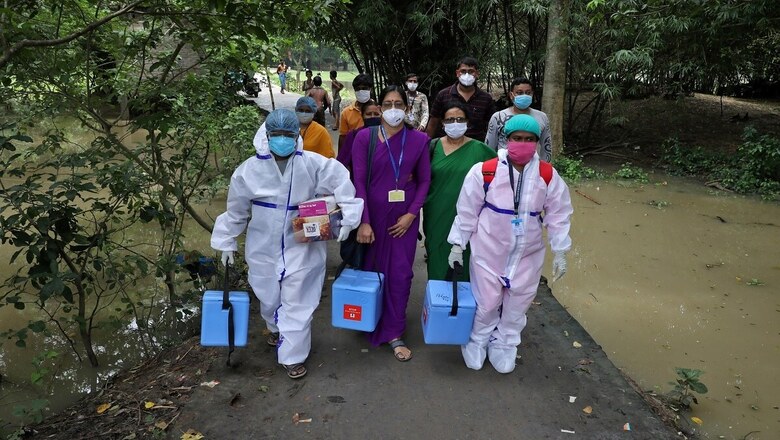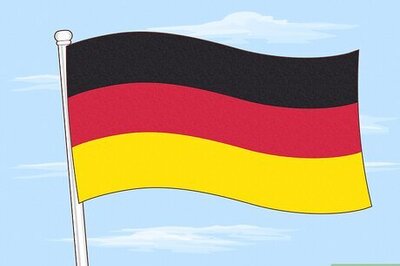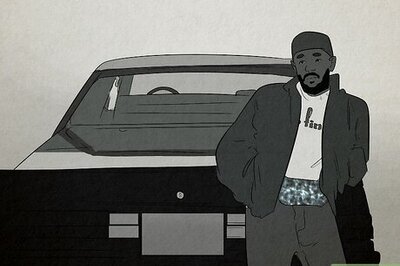
views
When the Principal Scientific Advisor (PSA) to the Government of India warned the country, a few weeks ago, of an inevitable third wave of the pandemic, there was alarm among the people and outcry in the media. This was understandable in a country which was still to emerge fully from the terrifying experience of a massive second wave. The PSA then corrected his prediction, saying that while a third wave was likely, we could avoid it if we take strong measures. The inevitable became the avertable, in a switch to positive messaging. While that partially abated the alarm, speculation on the third wave continued among scientists, media and the lay public.
How likely is a third wave? The fact that the virus is still actively circulating in the country makes it possible. The relentless global spread of the Delta variant and the recent emergence of the Delta Plus variant (AY.1) indicate that the virus still retains the capacity to infect speedily, while continuing to enhance its ability to do so through fresh mutations. With only around 20% of the adult population receiving a vaccine shot so far and around 4% fully vaccinated, there are many susceptible persons who are available for the virus to strike at. So, a third wave is possible.
What are the ‘strong measures’ we can take to avert it? The fact that there are still several susceptible persons in the population does not mean that they should expose themselves to the virus and allow it to enter their bodies with ease. If such persons wear face masks, move or work in well ventilated areas and avoid crowds, the risk of infection is greatly reduced. If most Indians observe that discipline till vaccination rates cross 60%, a third wave can be averted or greatly attenuated. We can make it a ripple rather than a tidal wave.
Many will argue that this is unrealistic. People have pandemic fatigue, are tired of lockdowns and rearing to get back to a bustling lifestyle of uninhibited socialisation, unrestricted travel and unrestrained celebration. The decline of the second wave would be misinterpreted by many as an ‘all clear’ signal to assume normalcy and shed caution. Preventing super spreader gatherings may no longer be a priority for authorities, as economic revival and electoral politics may take precedence. We saw that happen before the second wave. It can happen again, as subjective desires of people and politicians obscure the objective reality that the virus still has its pads on. The lull in virus transmission may be a short break in play and not signal end of the match. Both prudent prevention and the counterfactual of castaway caution exist as possible patterns of public behaviour.
When will the third wave arrive? There has been much speculation. A leading government expert has said it might happen in 6-8 weeks. Some modellers have said it would start in August and end in October. Others have said it would start in November. So far, the virus has not displayed a consistent weather or seasonal pattern. If there is one, it has been obscured by the timing and length of lockdowns, the varied patterns of unlocking and the behaviour of people when restrictions are lifted.
Unlike the predictable ‘flu’ season, there have been too many variables of human behaviour which have made the prediction of seasonal patterns difficult. The models study how the virus behaves under certain conditions of its growth and spread, but do not account for variations in people’s adherence to public health advisories and the alacrity of administrative response to changing trends. We do not also know if even more variants will emerge, with greater infectivity to trigger the next wave. So, we live with uncertainty about the timing. We should, therefore, gear up our systems for a possible early surge, while hoping for a long break between the waves.
ALSO READ | COVID-19 Management Guidelines Important for Uniformity, but Not Written in Stone
Will the virus cause as much, more, or less severe disease in the third wave than in the second wave? That depends on whether we define severity in terms of case counts of all infected persons, people infected severely enough to require hospitalisation or the number of deaths. The virus itself probably did not become more virulent during the second wave, but the huge surge resulted in the absolute number of serious cases rapidly rising to high numbers. Hospital services were overwhelmed as a result, compounded by mild cases too seeking hospital care. Will that happen again? Can we prevent that by containing the transmission, reducing case numbers and improving home care to keep the mild cases away from the hospitals? We must try in earnest to do so.
A recent study, by the Indian Council of Medical Research and the Imperial College at London, concluded that the third wave will be less devastating than the second wave. The conclusion is based on the plausible assumption that many who have been infected earlier would retain their immunity, fully or partially. The situation could change if new variants arrive which override the immunity provided by earlier infections. Even then, it is unlikely that the new variants will be more virulent. While they may infect more people, it is unlikely that they will cause more severe disease. That holds true for protection from vaccines too. New variants may display higher levels of vaccine evasion but most vaccines will still provide a fair amount of protection against severe disease and death. Our health and administrative systems will also be better prepared than they were during the second wave, when they were caught off guard. For all of these reasons, the third wave is likely to be less severe than the second.
Will children be more affected during the third wave? This has been the subject of considerable speculation after some doctors prophesied that children will become sick in large numbers when the third wave hits. Children are more likely to be exposed to the virus than in the first wave when they were mostly sheltered or during the second wave when they were only partly exposed. Many adults would have gained protection by the time a third wave rises, through immunity gained from prior infection or vaccination. So, the proportion of children infected will increase in comparison to adults.
However, infection will still tend to be milder in children. The ACE-2 receptors on human cells, which the virus attaches to for entering the body’s organs and blood vessels, are not as extensively developed in children as in adults. Children also have lower prevalence of associated health conditions like hypertension, diabetes, heart disease and lung disorders that increase the risk of severe Covid disease. A small proportion will suffer from Multi-System Inflammatory Disease of Children (MIS-C) but the vast majority of children will have a mild course. Increasing healthcare facilities for children, including intensive care units, will still be useful as they will serve to meet the needs of many other health conditions.
ALSO READ | Epidemics, Pandemics May Become More Regular. Genome Sequencing is Our Best Tool to Prepare
Increasing vaccination rates is a high priority. Vaccines confer stronger and longer immunity than natural infection which has a variable viral load. If we achieve 60% coverage, the rates of infection and deaths will come down sharply, as seen in Serrana province of Brazil. Even as we open up our society after the second wave recedes, we must ensure disciplined observance of public health advisories on masking, ventilation, avoidance of crowding and non-essential travel. Super-spreader events must be forbidden for rest of the year. Home care, emergency transport, secondary care facilities with oxygen and tertiary hospitals with intensive care units must be meticulously planned, prepared and monitored for response readiness and efficient functioning. Temporary hospitals and intermediate care centres established during the second wave should not be dismantled but kept active by treating non-Covid patients. People’s engagement must be strengthened through village and ?basti? level committees and training of citizen volunteers.
Preparation for, and response to, a third wave will require a concerted nationwide effort, requiring excellent centre-state coordination. That was seen in 2020 but not friction-free in 2021. Transcending political divides, governments across the country must work as a unified force, through consultative decision making and collaborative implementation processes. Only then can the danger of the third wave be dissipated before it inflicts much damage.
Read all the Latest News, Breaking News and Coronavirus News here.




















Comments
0 comment